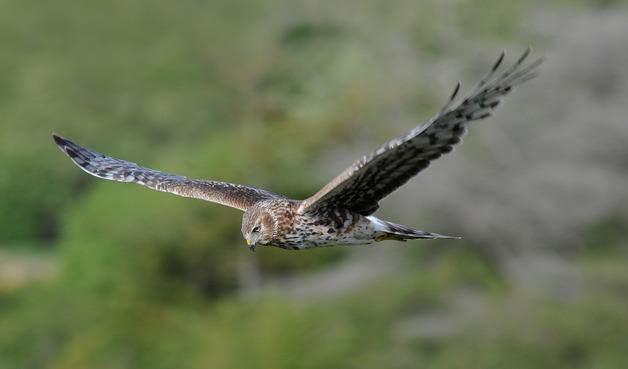While having coffee with a friend recently, she suggested, “Why don’t you write about bird flight. I’d like to know what those birds are that make a wave pattern as they fly through my garden.”
It got me thinking how much of bird identification can depend on flight behavior. Is the flight fast and direct? Slow and meandering? Is the bird hovering or soaring? Paying attention to flight behavior can be a joy in itself and is one more way to deepen our connections to the natural world.
As we sat, I noticed a black bird out of the corner of my eye. I didn’t even have to look directly at it to know it was a crow. No other species around here flies like crows do.
The basics of flight behavior are pretty obvious. Big birds like the great blue heron have large wings and a slow, deliberate wing beat. You could easily count the beats. At the other end of the size scale, hummingbirds have a fast, rapid wing beat. It’s impossible to count those beats, sometimes as fast as 80 beats per second. But flight behavior is not just a matter of wing size versus body weight.
Birds fly to locate and capture food, to escape from danger and to migrate. Some take short flights from tree to tree or tree to ground. Others take miles-long flights.
Swallows consume their prey on the wing, flitting and gliding through the air. Once they spot an insect, the birds dart to snatch it into their mouths.
Gulls soar over large stretches of water, holding their wings still and catching wind currents. Hawks do the same over land. They are keeping an eye out for their prey down on the water or land. When they locate something tempting, they descend quickly.
The champions of all soaring birds are the albatrosses. They stay aloft for days at a time and even sleep on the wing. Soaring preserves their energy for these long flights.
Another flight characteristic to watch for is hovering. You’ve probably observed a hummingbird hover near your feeder or as it sips nectar from a flower. They have an amazing ability to pause mid-air without moving even a fraction of an inch. This is accomplished by beating their wings in a more or less figure-eight pattern with the “eight” lying on its side.
If you’ve seen a small hawk hovering over open fields, it’s likely a kestrel. Hanging in one position, by flying into the wind at a speed equal to the wind, allows the raptor to scan the ground without alerting its prey. 
Kingfishers are also excellent at this skill. They hover over fairly shallow water watching for fish. When they spot dinner, they plunge down to capture their prey in their beaks.
Birds also fly to get from point A to point B. They might be moving from roosting areas to feeding areas or migrating. Loons, cormorants and diving ducks fly low over the water with fast, strong wing beats, looking for the entire world like they will fall out of the sky at any moment, yet stay airborne for miles.
Whidbey’s favorite seabird, the pigeon guillemot, searches for food at the bottom of the bay and its wings are designed more for “flying” underwater than for above-water flight.
Sparrows, quail and other ground feeders scurry to cover in shrubs or other thick vegetation rather than fly off. When they do fly, it’s a quick burst of energy.
Woodpeckers display a strong, undulating flight with short glides in between their wing beats.
Bushtits definitely romp. They move from branch to branch in a helter-skelter manner, thoroughly exploring one tree and then one-by-one they cavort off to another tree.
Chickadees caper through branches searching for insect larva. Finches frolic as they fly with a wave-like flight pattern.
Flight patterns can also help with some difficult to distinguish species. For example, crows and ravens fly very differently. Crows have a smooth, “rowing” action and never soar; ravens often soar and engage is aerial acrobatics.
Sometimes the only way to tell a Cooper’s hawk from a sharp-shinned hawk is by the flight. Watch for the sharp-shinned’s quick little shimmy as it careens through the woods. The Cooper’s flight pattern is more stiff and choppy.
I hope this quick introduction to flight behavior has helped. Now, you won’t have to wait until a bird lands to begin your identification and to appreciate our fascinating avian friends.
Frances Wood can be reached at wood@whidbey.com. Craig Johnson is at Craigjohnson@whidbey.com.


